Abstract
The H+-translocating ATPase complex from the thermophilic bacterium PS3 (TF0-F1) is composed of a water-soluble part with ATP-hydrolyzing activity (TF1) and a membrane moiety with H+-conducting activity (TF0). TF0 was obtained by treating TF0-F1 with urea and removing contaminations on a carboxymethyl-cellulose column. This TF0 contained only two kinds of subunits, band 6 protein (13,500 daltons) and band 8 protein (5400 daltons), and it was active in H+ conduction and TF1 binding when reconstituted into proteoliposomes (TF0 vesicles). The binding of TF1 to TF0 present in vesicles restored energy-transducing activities, such as ATP-32Pi exchange, dicyclohexylcarbodiimide-sensitive ATPase, and ATP-dependent enhancement of 8-anilinonaphthalene-1-sulfonate fluorescence. Treatments such as protease digestion and chemical modification with acetic anhydride, succinic anhydride, or diazobenzenesulfonic acid destroyed the TF1-binding activity, which was caused by band 6 protein. Band 8 protein was a proteolipid that reacted specifically with dicylcohexyl-carbodiimide and seemed to play a central role in H+ conduction through the membrane.
Full text
PDF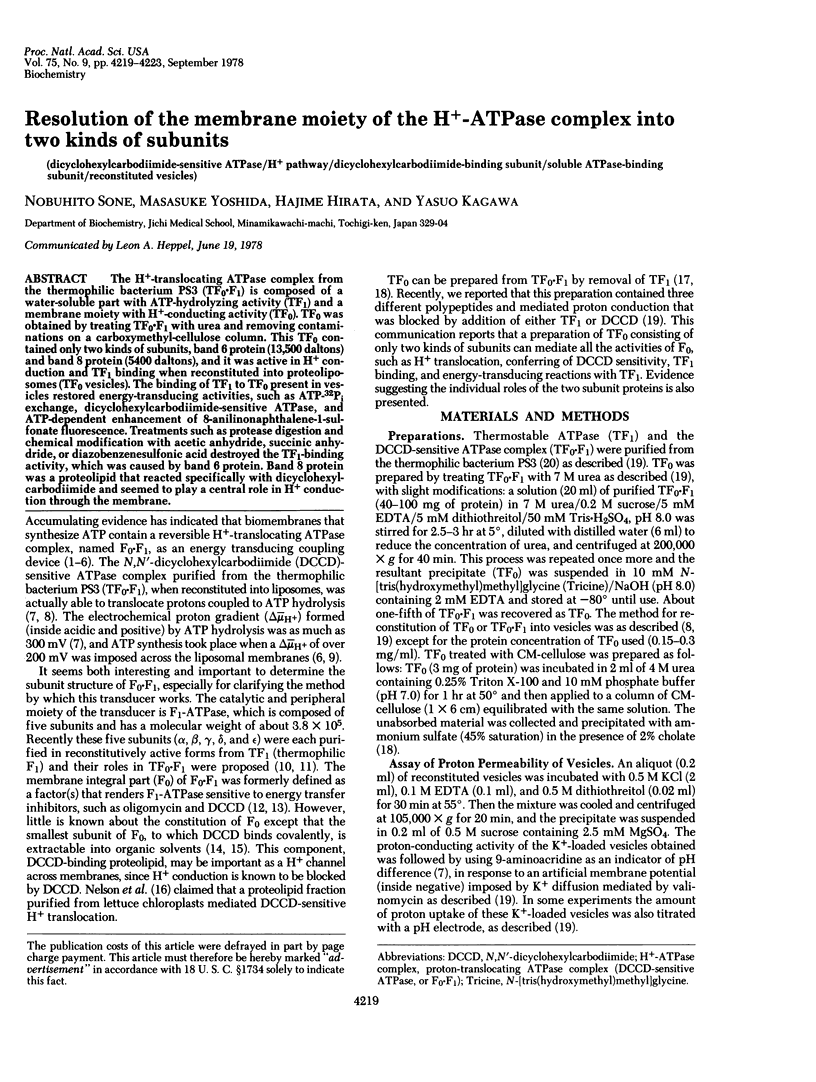
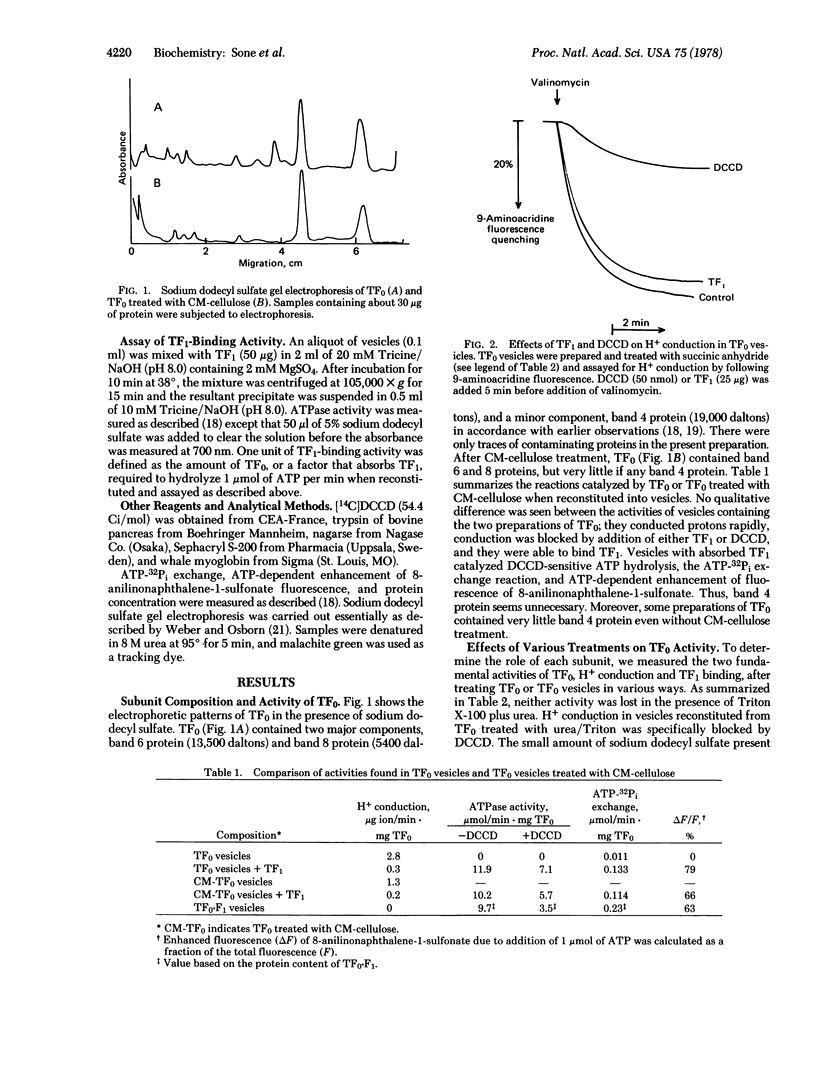
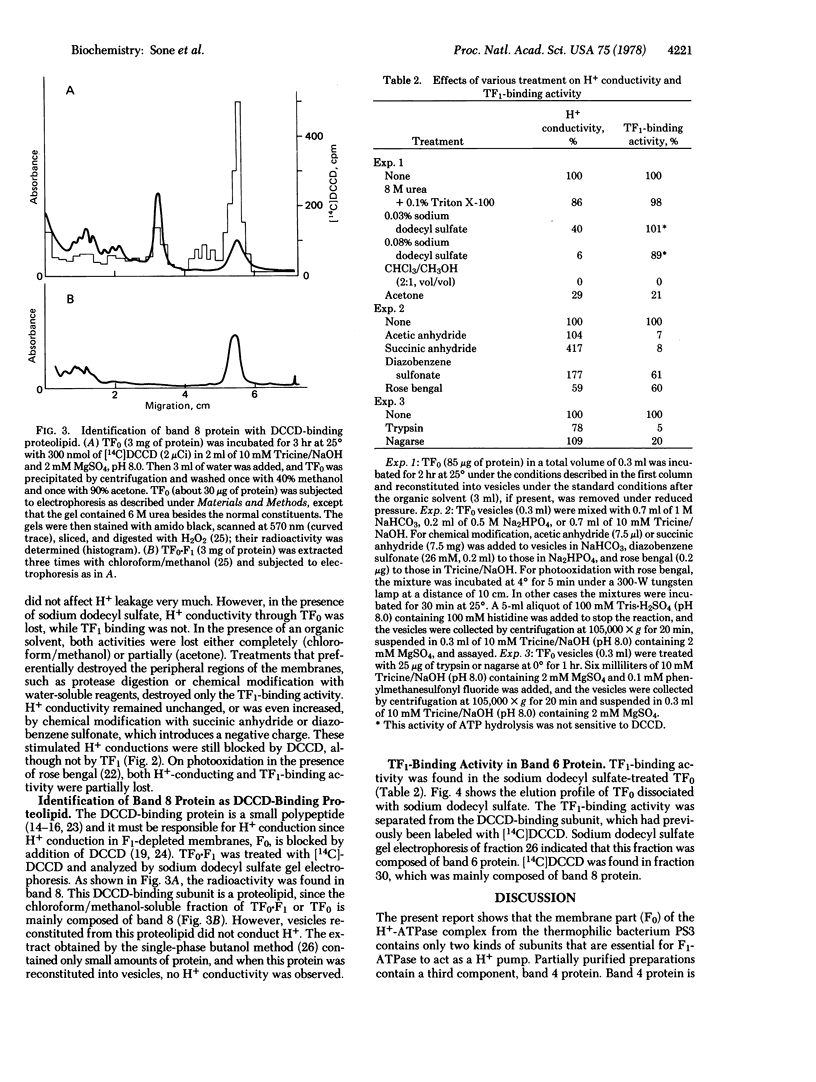
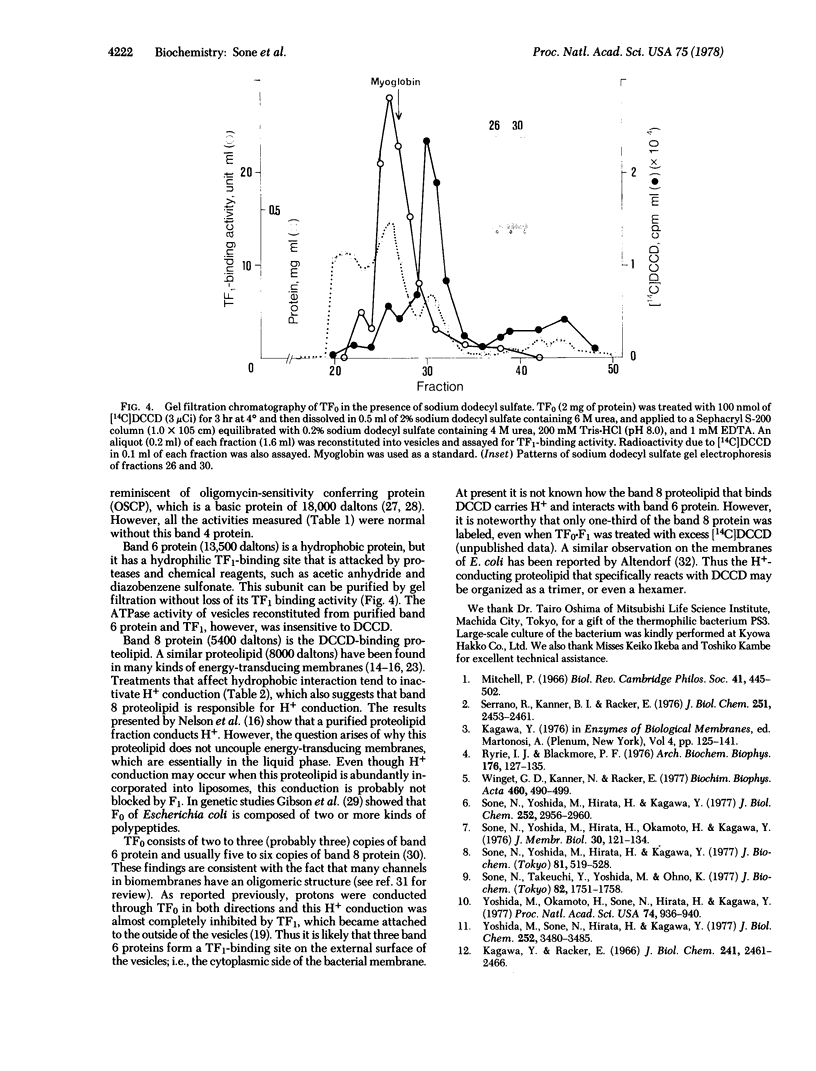
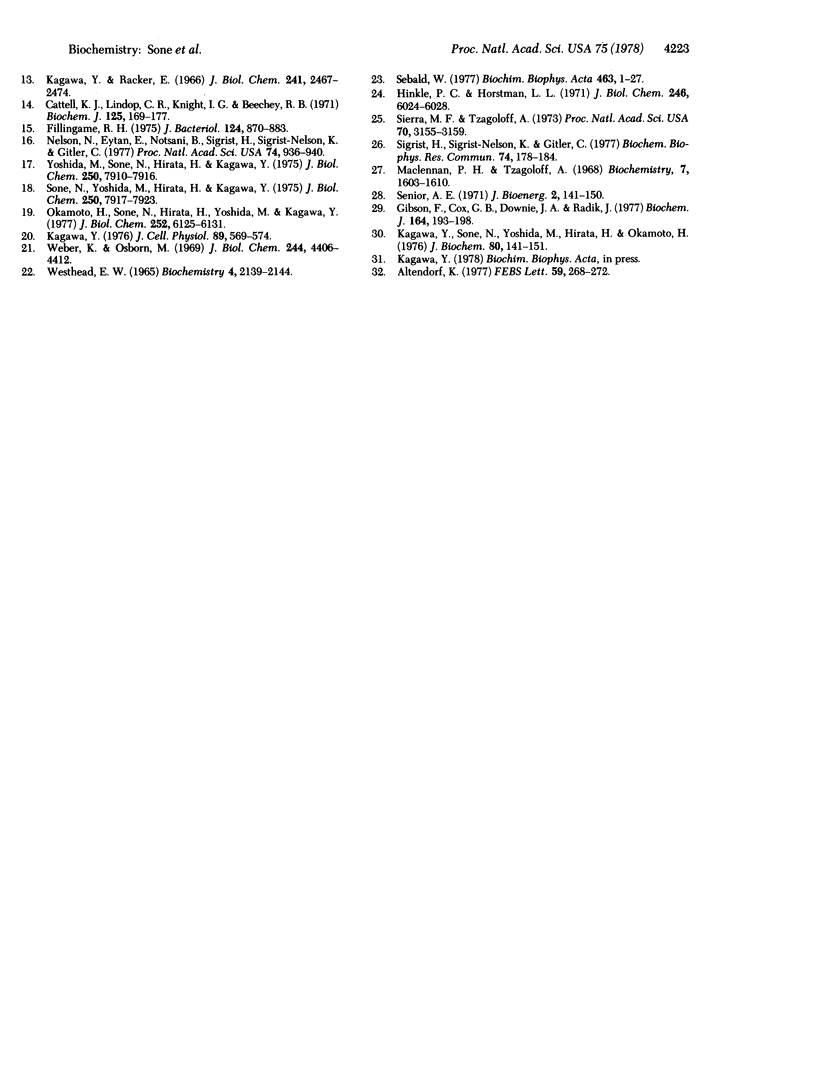
Images in this article
Selected References
These references are in PubMed. This may not be the complete list of references from this article.
- Altendorf K., Zitzmann W. Identification of the DCCD-reactive protein of the energy transducing adenosinetriphosphatase complex from Escherichia coli. FEBS Lett. 1975 Nov 15;59(2):268–272. doi: 10.1016/0014-5793(75)80390-5. [DOI] [PubMed] [Google Scholar]
- Cattell K. J., Lindop C. R., Knight I. G., Beechey R. B. The identification of the site of action of NN'-dicyclohexylcarbodi-imide as a proteolipid in mitochondrial membranes. Biochem J. 1971 Nov;125(1):169–177. doi: 10.1042/bj1250169. [DOI] [PMC free article] [PubMed] [Google Scholar]
- Fillingame R. H. Identification of the dicyclohexylcarbodiimide-reactive protein component of the adenosine 5'-triphosphate energy-transducing system of Escherichia coli. J Bacteriol. 1975 Nov;124(2):870–883. doi: 10.1128/jb.124.2.870-883.1975. [DOI] [PMC free article] [PubMed] [Google Scholar]
- Gibson F., Cox G. B., Downie J. A., Radik J. A mutation affecting a second component of the F0 portion of the magnesium ion-stimulated adenosine triphosphatase of Escherichia coli K12. The uncC424 allele. Biochem J. 1977 Apr 15;164(1):193–198. doi: 10.1042/bj1640193. [DOI] [PMC free article] [PubMed] [Google Scholar]
- Hinkle P. C., Horstman L. L. Respiration-driven proton transport in submitochondrial particles. J Biol Chem. 1971 Oct 10;246(19):6024–6028. [PubMed] [Google Scholar]
- Kagawa Y., Racker E. Partial resolution of the enzymes catalyzing oxidative phosphorylation. 8. Properties of a factor conferring oligomycin sensitivity on mitochondrial adenosine triphosphatase. J Biol Chem. 1966 May 25;241(10):2461–2466. [PubMed] [Google Scholar]
- Kagawa Y., Racker E. Partial resolution of the enzymes catalyzing oxidative phosphorylation. IX. Reconstruction of oligomycin-sensitive adenosine triphosphatase. J Biol Chem. 1966 May 25;241(10):2467–2474. [PubMed] [Google Scholar]
- Kagawa Y., Sone N., Yoshida M., Hirata H., Okamoto H. Proton translocating ATPase of a thermophilic bacterium. Morphology, subunits, and chemical composition. J Biochem. 1976 Jul;80(1):141–151. doi: 10.1093/oxfordjournals.jbchem.a131246. [DOI] [PubMed] [Google Scholar]
- Kagawa Y. Transport of nutrients by a thermophilic bacterium--reconstruction of vesicles from crystalline ATPase or solubilized alanine carrier. J Cell Physiol. 1976 Dec;89(4):569–573. doi: 10.1002/jcp.1040890413. [DOI] [PubMed] [Google Scholar]
- MacLennan D. H., Tzagoloff A. Studies on the mitochondrial adenosine triphosphatase system. IV. Purification and characterization of the oligomycin sensitivity conferring protein. Biochemistry. 1968 Apr;7(4):1603–1610. doi: 10.1021/bi00844a050. [DOI] [PubMed] [Google Scholar]
- Mitchell P. Chemiosmotic coupling in oxidative and photosynthetic phosphorylation. Biol Rev Camb Philos Soc. 1966 Aug;41(3):445–502. doi: 10.1111/j.1469-185x.1966.tb01501.x. [DOI] [PubMed] [Google Scholar]
- Okamoto H., Sone N., Hirata H., Yoshida M., Kagawa Y. Purified proton conductor in proton translocating adenosine triphosphatase of a thermophilic bacterium. J Biol Chem. 1977 Sep 10;252(17):6125–6131. [PubMed] [Google Scholar]
- Ryrie I. J., Blackmore P. F. Energy-linked activities in reconstituted yeast adenosine triphosphatase proteoliposome. Adenosine triphosphate formation coupled with electron flow between ascorbate and ferricyanide. Arch Biochem Biophys. 1976 Sep;176(1):127–135. doi: 10.1016/0003-9861(76)90148-x. [DOI] [PubMed] [Google Scholar]
- Sebald W. Biogenesis of mitochondrial ATPase. Biochim Biophys Acta. 1977 Jun 21;463(1):1–27. doi: 10.1016/0304-4173(77)90002-7. [DOI] [PubMed] [Google Scholar]
- Senior A. E. On the relationship between the oligomycin-sensitivity conferring protein and other mitochondrial coupling factors. J Bioenerg. 1971 Aug;2(3):141–150. doi: 10.1007/BF01648909. [DOI] [PubMed] [Google Scholar]
- Serrano R., Kanner B. I., Racker E. Purification and properties of the proton-translocating adenosine triphosphatase complex of bovine heart mitochondria. J Biol Chem. 1976 Apr 25;251(8):2453–2461. [PubMed] [Google Scholar]
- Sierra M. F., Tzagoloff A. Assembly of the mitochondrial system. Purification of a mitochondrial product of the ATPase. Proc Natl Acad Sci U S A. 1973 Nov;70(11):3155–3159. doi: 10.1073/pnas.70.11.3155. [DOI] [PMC free article] [PubMed] [Google Scholar]
- Sigrist H., Sigrist-Nelson K., Gitler C. Single-phase butanol extraction: a new tool for proteolipid isolation. Biochem Biophys Res Commun. 1977 Jan 10;74(1):178–184. doi: 10.1016/0006-291x(77)91391-2. [DOI] [PubMed] [Google Scholar]
- Sone N., Takeuchi Y., Yoshida M., Ohno K. Formations of electrochemical proton gradient and adenosine triphosphate in proteoliposomes containing purified adenosine triphosphatase and bacteriorhodopsin. J Biochem. 1977 Dec;82(6):1751–1758. doi: 10.1093/oxfordjournals.jbchem.a131873. [DOI] [PubMed] [Google Scholar]
- Sone N., Yoshida M., Hirata H., Kagawa Y. Adenosine triphosphate synthesis by electrochemical proton gradient in vesicles reconstituted from purified adenosine triphosphatase and phospholipids of thermophilic bacterium. J Biol Chem. 1977 May 10;252(9):2956–2960. [PubMed] [Google Scholar]
- Sone N., Yoshida M., Hirata H., Kagawa Y. Purification and properties of a dicyclohexylcarbodiimide-sensitive adenosine triphosphatase from a thermophilic bacterium. J Biol Chem. 1975 Oct 10;250(19):7917–7923. [PubMed] [Google Scholar]
- Sone N., Yoshida M., Hirata H., Kagawa Y. Reconstitution of vesicles capable of energy transformation from phospholipids and adenosine triphosphatase of a thermophilic bacterium. J Biochem. 1977 Feb;81(2):519–528. doi: 10.1093/oxfordjournals.jbchem.a131485. [DOI] [PubMed] [Google Scholar]
- Sone N., Yoshida M., Hirata H., Okamoto H., Kagawa Y. Electrochemical potential of protons in vesicles reconstituted from purified, proton-translocating adenosine triphosphatase. J Membr Biol. 1976 Dec 28;30(2):121–134. doi: 10.1007/BF01869663. [DOI] [PubMed] [Google Scholar]
- Weber K., Osborn M. The reliability of molecular weight determinations by dodecyl sulfate-polyacrylamide gel electrophoresis. J Biol Chem. 1969 Aug 25;244(16):4406–4412. [PubMed] [Google Scholar]
- Winget G. D., Kanner N., Racker E. Formation of ATP by the adenosine triphosphatase complex from spinach chloroplasts reconstituted together with bacteriorhodopsin. Biochim Biophys Acta. 1977 Jun 9;460(3):490–499. doi: 10.1016/0005-2728(77)90087-1. [DOI] [PubMed] [Google Scholar]
- Yoshida M., Okamoto H., Sone N., Hirata H., Kagawa Y. Reconstitution of thermostable ATPase capable of energy coupling from its purified subunits. Proc Natl Acad Sci U S A. 1977 Mar;74(3):936–940. doi: 10.1073/pnas.74.3.936. [DOI] [PMC free article] [PubMed] [Google Scholar]
- Yoshida M., Okamoto H., Sone N., Hirata H., Kagawa Y. Reconstitution of thermostable ATPase capable of energy coupling from its purified subunits. Proc Natl Acad Sci U S A. 1977 Mar;74(3):936–940. doi: 10.1073/pnas.74.3.936. [DOI] [PMC free article] [PubMed] [Google Scholar]
- Yoshida M., Sone N., Hirata H., Kagawa Y. A highly stable adenosine triphosphatase from a thermophillie bacterium. Purification, properties, and reconstitution. J Biol Chem. 1975 Oct 10;250(19):7910–7916. [PubMed] [Google Scholar]
- Yoshida M., Sone N., Hirata H., Kagawa Y. Reconstitution of adenosine triphosphatase of thermophilic bacterium from purified individual subunits. J Biol Chem. 1977 May 25;252(10):3480–3485. [PubMed] [Google Scholar]



